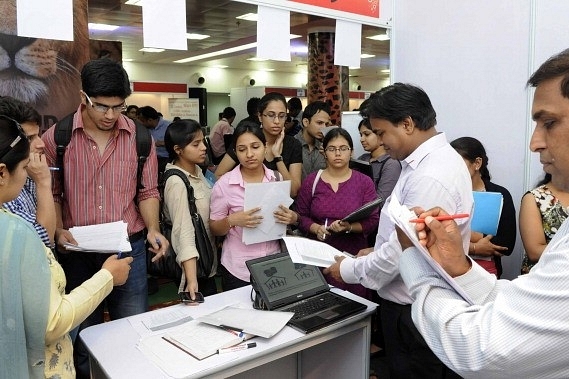Economy
As 2.4 Million Government Jobs Stay Vacant, A Dotted Line Links Farm Loan Waivers And Freebie Culture To ‘Jobless’ Growth
- Those who rail about “jobless” growth should know that the endless election cycle is one contributory cause.
- Millions of jobs are there for the asking, but there isn’t cash or the political will to fill the vacancies.

Students at a campus job fair organised by Delhi University Students Union in New Delhi. (Sushil Kumar/Hindustan Times via GettyImages)
There are, it seems, around 2.4 million unfilled job vacancies in government, according to a collation of answers filed in the Rajya Sabha. If this is the level of vacancies merely in known state-controlled areas, one wonders why governments at Centre and states are not filling them up to claim higher jobs growth?
Of these vacancies, the biggest chunk in is education (over one million), followed by police forces (6 lakh, including paramilitary forces), railways (2.4 lakh), social services (2.2 lakh anganwadi workers) and healthcare (1.5 lakh), according to a Times of India report.
But before we jump to any conclusions on governments not doing the obvious, two points are worth making.
First, these vacancies are broadly in what one can call high-touch sectors, where human labour is unavoidable. They can’t be easily automated. These vacancies clearly suggest that skill-gaps exist in the social sectors and quick skilling can make a huge difference to job creation.
Second, and this is the real worry, it is likely that many, if not most, of these jobs are not being filled because state budgets may be stretched. Thus, vacant posts are left vacant in order to stay within fiscal limits, both at Centre and states.
Logically, if so many jobs are lying vacant, governments in election mode – which means practically all governments – ought to be in a rush to fill them in order to claim jobs growth. But the very fact that they are not being filled points us to a serious problem.
When states waive farm loans (collective waivers over the last two years add up to around Rs 1.5 lakh crore) and offer other freebies, effectively reducing their fiscal elbowrooms and otherwise bankrupting themselves, the most obvious areas to cut spending are two-fold: leaving vacancies unfilled, or projects underfunded. One impacts short-term job creation, and the other future jobs.
Not for nothing did the Chief Economic Adviser, Arvind Subramanian, point out last year that the loan waivers will negatively impact GDP growth.
Freebies and waivers are “private goods”, defined as goods whose consumption by one denies the same to another. A freebie offered to farmers means the same money will be denied to others. On the other hand, spending on law and order, or education or health is a “public good” – spending in these areas benefit all sections. Consumption of an “education” service by one section does not deny anyone else the same benefit.
The 2.4 million unfilled vacancies are the grossest evidence yet that all governments need to increase their spending on public goods as opposed to private goods. The political reason why this does not happen is that the provision of subsidies and freebies to a narrow section of voters may enable a party to win the next election. This comes at a cost. The non-provision of public goods destroys the very basis for future growth and jobs.
A continuous and annual election cycle thus ensures that all political parties will seek to maximise short-term votes by offering favoured sections “private goods” at the cost of “public goods”. This is the strongest case ever made for holding all major national and state elections at one time – or at best in two rounds, each held every two-and-a-half years.
Those who rail about “jobless” growth should know that the endless election cycle is one contributory cause. Millions of jobs are there for the asking, but there isn’t cash or the political will to fill the vacancies.
Support Swarajya's 50 Ground Reports Project & Sponsor A Story
Every general election Swarajya does a 50 ground reports project.
Aimed only at serious readers and those who appreciate the nuances of political undercurrents, the project provides a sense of India's electoral landscape. As you know, these reports are produced after considerable investment of travel, time and effort on the ground.
This time too we've kicked off the project in style and have covered over 30 constituencies already. If you're someone who appreciates such work and have enjoyed our coverage please consider sponsoring a ground report for just Rs 2999 to Rs 19,999 - it goes a long way in helping us produce more quality reportage.
You can also back this project by becoming a subscriber for as little as Rs 999 - so do click on this links and choose a plan that suits you and back us.
Click below to contribute.
Latest